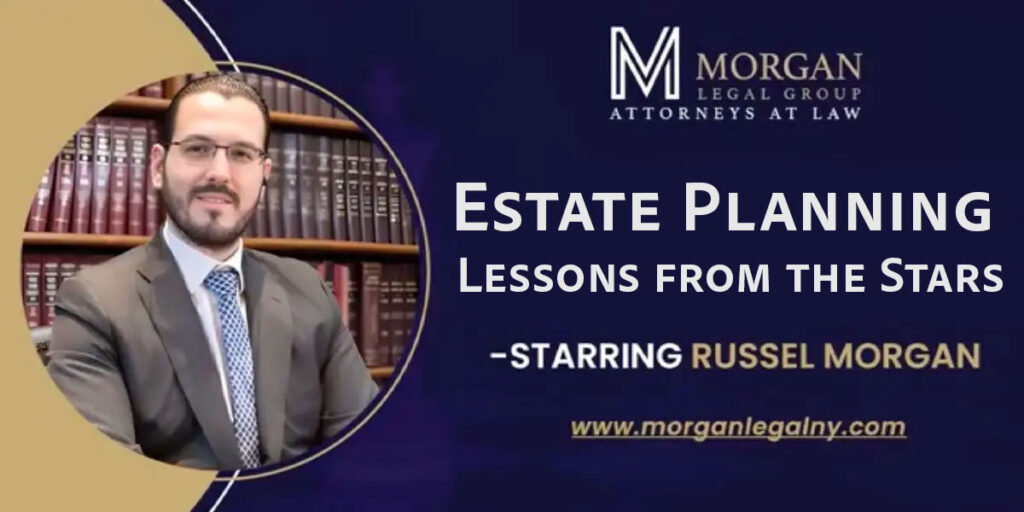Celebrity Wills Gone Wrong: An Attorney’s Guide to Protecting Your Legacy
The lives of celebrities fascinate us. We follow their careers, their triumphs, and their personal lives with keen interest. But often, the most important and instructive part of their story is the one that unfolds after they are gone. When a high-profile individual dies, their estate plan—or lack thereof—is often thrust into the public spotlight, revealing a world of conflict, confusion, and catastrophic financial errors. These public sagas, while tragic for the families involved, offer us some of the most powerful and accessible lessons in the importance of proper estate planning.
As a New York estate planning attorney with more than 30 years of experience, I have seen these same mistakes play out time and again, not just with celebrities, but with families from all walks of life right here in our community. The only difference is that the sums involved are smaller, but the emotional and financial devastation is just as real. In a recent episode of “Obsessed with Success,” our firm’s founder, Russel Morgan, Esq., broke down some of the most infamous celebrity cases. At Morgan Legal Group, we believe these stories are more than just gossip; they are profound cautionary tales. This guide will take a deep dive into those cases, exploring the specific New York laws at play and providing a clear roadmap for how you can avoid making these same costly mistakes.
The Ultimate cautionary Tale: Prince and the Catastrophe of Having No Will
The 2016 death of the musical icon Prince is, without a doubt, the modern poster child for the disastrous consequences of dying without an estate plan. Despite a vast fortune estimated at over $150 million, Prince died “intestate,” meaning he had no will, no trust, and no plan of any kind. This single oversight unleashed a legal and financial storm that raged for six long years.
The Immediate Aftermath: A Legal Free-for-All
Because Prince left no instructions, the court in his home state of Minnesota was forced to step in and manage everything. The immediate result was chaos. Dozens of people came forward claiming to be his wife, child, or sibling. The court had to spend an immense amount of time and money just to determine who his legal heirs were. Ultimately, his estate was divided between his six surviving siblings.
The Six-Year Battle and Its Devastating Costs
The settlement of Prince’s estate was a grueling marathon of legal disputes. The heirs, lawyers, and estate administrators fought over everything, from the valuation of his unreleased music catalog to the management of his Paisley Park complex.
- Financial Cost: The legal and administrative fees for this six-year battle reportedly topped $10 million. This was money that should have gone to his family but was instead consumed by the legal process.
- Loss of Privacy: Every detail of his finances, his assets, and his family disputes became a matter of public record, open for the world to see.
- Loss of Control: Prince, a notoriously private and meticulous artist, lost all control over his legacy. Decisions about his music and his image were made by court-appointed administrators and warring family members, not by a trusted person of his own choosing.
How This Would Play Out in New York
If a resident of New York City were to die intestate, the result would be the same chaos, governed by New York’s intestacy laws. The court would have to supervise a lengthy and expensive administration proceeding. A court-appointed administrator, who may be a stranger to the family, would be put in charge. Your assets would be distributed according to a rigid statutory formula. For example:
- If you have a spouse and children, your spouse gets the first $50,000 and half the rest. Your children get the other half.
- If you have no spouse or children, your parents inherit everything.
- If you have no parents, your siblings inherit.
This formula makes no exceptions for your unmarried partner, a favorite niece, or a lifelong best friend. It is cold and impersonal.
The Core Lesson from Prince:
The most basic will would have prevented this entire disaster. With a simple will, Prince could have named his chosen heirs, appointed an Executor he trusted, and laid out his wishes, saving his family millions of dollars and years of conflict. The failure to take this fundamental first step was his most costly mistake.
Heath Ledger and the Peril of an Outdated Plan
The tragic death of actor Heath Ledger in 2008 provides a different but equally important lesson. Unlike Prince, Ledger had a will. The problem was that the will was dangerously out of date.
A Will Frozen in Time
Ledger created his will in 2003. At that time, he was unmarried and had no children. His will left his entire estate to his parents and his sister. However, in 2005, his daughter, Matilda, was born. Ledger tragically passed away before he ever had a chance to update his will to include her. Legally, his entire estate was set to bypass his only child and go to her grandparents and aunt.
Saved by Grace, Not by Law
Fortunately for Matilda, this story has a positive outcome. Ledger’s family was incredibly gracious and announced that they would give the entirety of the estate to her benefit. They did the right thing. However, it is absolutely critical to understand that they were under **no legal obligation** to do so. Had they chosen to follow the will’s legal text, his daughter would have been unintentionally disinherited. The plan’s failure created a situation where his daughter’s financial future depended entirely on the generosity of relatives, not the certainty of the law.
The “After-Born Child” Statute in New York
New York law does provide some protection for children who are born after a will is created. This “after-born child” statute may allow such a child to receive their intestate share of the estate. However, relying on this is risky. It can be complex to apply and can lead to court proceedings to interpret the parent’s intent. It is a legal safety net, not a substitute for proactive planning.
The Core Lesson from Heath Ledger:
An estate plan is not a “set it and forget it” document. It is a living document that must be reviewed and updated after every major life event. Marriage, divorce, the birth or adoption of a child, or a significant change in your financial situation are all “estate planning triggers” that should prompt an immediate call to your attorney. If you have experienced one of these events, you must contact us for a review.
James Gandolfini and the Devastating Cost of Poor Tax Planning
The 2013 death of “The Sopranos” star James Gandolfini is a masterclass in how a poorly structured plan, even with a valid will, can lead to a massive and unnecessary loss of wealth to taxes.
A Generous but Tax-Inefficient Plan
Gandolfini’s will was very generous to his loved ones. However, it was a tax disaster. He left 20% of his estate to his wife, but the remaining 80% was left to other individuals, including his sisters and his infant daughter. While the portion left to his wife qualified for the unlimited marital deduction (meaning it passed to her estate-tax-free), the vast majority of his estimated $70 million estate did not.
The Eye-Watering Tax Bill
Because these large bequests were made to non-spouse individuals, they were subject to the full force of the federal and New York State estate taxes. The top tax rate at the time was approximately 55%. It is estimated that Gandolfini’s estate paid over $30 million in estate taxes. This was a staggering loss of wealth that could have been almost entirely avoided with proper planning.
The Tax-Saving Strategies He Ignored
An experienced estate planning attorney would have used several key strategies to protect Gandolfini’s estate:
- Maximizing the Marital Deduction: He could have left a larger portion of his estate to his wife, either outright or in a specially designed marital trust (like a QTIP trust). This would have deferred the estate tax until her later death, allowing the full, untaxed value of the estate to grow for her benefit.
- Using Credit Shelter Trusts:
- Irrevocable Life Insurance Trusts (ILITs):
The Core Lesson from James Gandolfini:
Proper estate planning is not just about deciding who gets your assets; it’s about structuring the transfer in the most tax-efficient way possible. A failure to plan for the “death tax” can be the single most expensive mistake you make.
A Positive Example: Jeff Bezos and the Power of Proactive Planning
While cautionary tales are powerful, it’s also important to look at positive examples. The ongoing philanthropic work of Amazon founder Jeff Bezos provides a masterclass in strategic, proactive estate management.
Lifetime Giving as a Planning Tool
Bezos has pledged to give away the majority of his vast fortune during his lifetime through his Bezos Earth Fund and other charitable initiatives. While his motives are philanthropic, this strategy has profound estate planning benefits.
The Benefits of Strategic Philanthropy:
- Tax Advantages: Every dollar he gives to a qualified charity is a dollar that is removed from his future taxable estate. Furthermore, he receives a significant current income tax deduction for his charitable contributions.
- Impact and Control:
- Shaping a Legacy:
How This Applies to You
You don’t need to be a billionaire to use these same principles. Strategic charitable giving, using tools like Donor-Advised Funds or Charitable Remainder Trusts, can be a powerful part of an estate plan for many affluent New Yorkers. It allows you to support the causes you care about while simultaneously reducing your future estate tax bill. This is an area where a knowledgeable attorney can provide immense value. When you’re ready, you can schedule a meeting to discuss these advanced strategies.
For more on this topic, authoritative sources like the Fidelity Charitable foundation provide excellent educational resources.
The Most Common Mistakes We Can All Avoid
The lessons from these celebrity estates are universal. You don’t need a massive fortune to fall into the same traps. The most common mistakes we see every day are the same ones that plagued these famous names:
- Having No Plan at All: The Prince mistake. This is the cardinal sin of estate planning. It guarantees a public, expensive, and lengthy court process.
- Having an Outdated Plan: The Heath Ledger mistake. A plan that doesn’t reflect your current life can be as dangerous as no plan at all.
- Ignoring Tax Consequences: The James Gandolfini mistake. A failure to plan for taxes can decimate your legacy.
- Failing to Plan for Incapacity:
- guardianship
- Power of Attorney
Your Legacy is Not a Dress Rehearsal
You only get one chance to get your estate plan right. The stories of these celebrities are a stark reminder that wealth does not equal wisdom. Without deliberate, professional guidance, even the largest estates can be brought to their knees by simple, avoidable mistakes.
At Morgan Legal Group, we are dedicated to ensuring our clients’ stories have a different ending. We provide the comprehensive, strategic counsel needed to navigate the complexities of New York law, protect your assets, and provide for your loved ones. We learn from the mistakes of others to build ironclad plans for you.
Your legacy is too important to leave to chance. Take the first step today to ensure your final chapter is one of peace, order, and security. Contact Morgan Legal Group to schedule a consultation and begin building your personalized estate plan. You can see what our many satisfied clients have to say about our work on Google.







